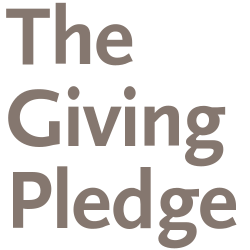Top Qs
Timeline
Chat
Perspective
The Giving Pledge
Charitable campaign From Wikipedia, the free encyclopedia
Remove ads
The Giving Pledge is a charitable campaign, founded by Bill Gates, Melinda French Gates, and Warren Buffett, to encourage wealthy people to contribute a majority (i.e. more than 50%) of their wealth to philanthropic causes. As of October 2025[ref], the pledge has over 250 signatories from 30 countries.[2] Most of the signatories of the pledge are billionaires, at a total of US$600 billion.[3]
Remove ads
Description
The organization's stated goal is to inspire the wealthy people of the world to give at least half of their net worth to philanthropy, either during their lifetime or upon their death. The pledge is a public gesture of an intention to give, not a legal contract.[4] On the Giving Pledge's website, each individual or couple writes a letter explaining why they chose to give.[5]
History
Summarize
Perspective
In June 2010, the Giving Pledge campaign was formally announced and Bill Gates, Melinda French Gates, and Warren Buffett began recruiting members.[6] As of August 2010, the aggregate wealth of the first 40 pledgers was $125 billion.[7] As of April 2011, 69 billionaires had joined the campaign and given a pledge,[8] and by the following year, The Huffington Post reported that a total of 81 billionaires had pledged.[9] By May 2017, 158 individuals and/or couples were listed as pledgers.[5][10][needs update] Not all pledgers are billionaires.
FTX founder Sam Bankman-Fried was removed from the list in December 2022 following his arrest.[11]
Banker T. Denny Sanford had his name removed from the list in May 2023 following the unsealing of court documents about his possible involvement with child pornography.[12]
The Giving Pledge was cited as inspiration for the Jewish Future Pledge, a charitable campaign launched in 2020 to encourage American Jews to give at least half of their charitable giving to Jewish- or Israel-related causes.[13]
Many pledge participants channel their philanthropy through private family foundations or donor-advised funds (DAFs) that they control, enabling immediate tax benefits while allowing disbursements over time. According to a 2025 report by the Institute for Policy Studies, roughly 80 percent of pledger contributions have gone to such intermediary organisations rather than directly to operating charities. Supporters argue this builds enduring endowments and professionalizes grantmaking, while critics contend it delays impact and preserves donor control, blurring the line between philanthropy and the maintenance of influence.[1][14]
The initiative has also attracted criticism from journalists, watchdog groups, and members of the philanthropic sector for its voluntary and non-binding nature, which provides no mechanism to verify or enforce the fulfilment of commitments. Commentators note that some signatories may gain public recognition without necessarily donating the pledged share, and that many participants have seen their net worth increase since joining. According to a 2025 analysis by the Institute for Policy Studies, the 32 original U.S. pledgers who remain billionaires have collectively become about 166 percent wealthier since signing on in 2010. According to the study, just 8 of 22 pledgers who have since died actually gave away enough to meet the "half of wealth" pledge by the time of their death.[1][14]
Remove ads
List of notable pledgers
Summarize
Perspective
Net worth is as of 2024[update] for notable signers. A full list of pledgers is available online.[15]
Remove ads
See also
References
External links
Wikiwand - on
Seamless Wikipedia browsing. On steroids.
Remove ads

